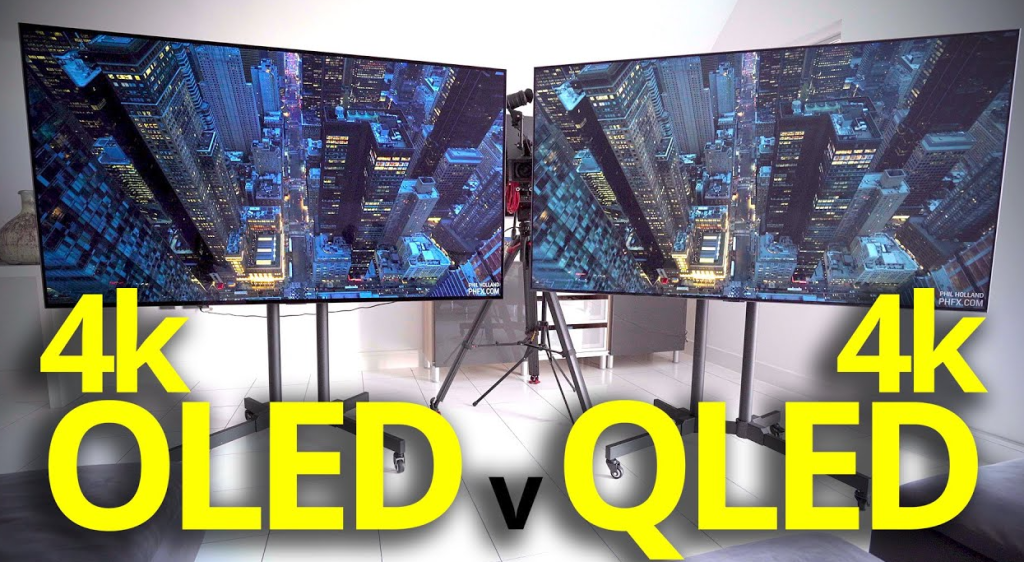
What’s happening
Two fundamentally different television technologies, QLED and OLED, have similar names.
Why is that important?
If you’re going to buy a new TV, you’ll want to know the difference between each technology.
What does that mean to you?
In our side-by-side reviews, OLED beats QLED every time. But that’s not the whole story.
In 2022, buying a new TV is as confusing as ever. The best tvs advertise confusing features like HDR, Ultra High Definition 4K, 120Hz and HDMI 2.1, making it hard to figure out what’s really worth it. The two biggest TV terms you’ll see are QLED and OLED. They differ by only one letter, but the techniques they describe are very different.
For the past few years, Samsung has been branding his TV “QLED.”. Its 2022 QLED lineup includes 4K and 8K Resolution NEO QLED models, The Frame ART TV, Serif and Sero Spin tvs, all with The ubiquitous Q. Tcl also produces QLED tvs, including the CNET Editor’s choice for the 6 series.
On the other side of the fence is an OLED TV. LG has dominated the OLED market for the past few years, with a wider OLED TV lineup in 2022 than ever before, but Sony and Vizio also produce OLED tvs in the US. What’s confusing is that Samsung also has its own OLED TV in 2022, so it will sell both OLED and QLED tvs this year.
So, what’s the difference between OLED and QLED? Let’s start with the quality. In our side-by-side review, OLED beat QLED every time. We recently compared our selection of OLED tvs-the LG C1 series-to the best Samsung 4K QLED tvs of 2022-the Samsung QN90B series. Samsung’s QLED is closer to LG OLED than ever, but LG still wins. We also compared the TCL 8K QLED TV to the 2022 LG OLED C2. Similarly, OLED TV won
QLED and OLED. A quick summary of TV technology
Let’s start with a quick classification.
- OLED stands for “Organic light-emitting diode.”.
- Qled (according to Samsung) stands for“Quantum dot LED TV”.
- OLED is a fundamentally different technology from LCD, the main type of television.
- QLED is a variant of LED LCD that incorporates quantum dot films into the LCD“Sandwich”.
- OLED is“Emitting”, meaning that pixels emit their own light.
- Qleds, like lcds, are“Transparent” in their current form and rely on an LED backlight.
QLED tvs are just liquid crystal televisions with quantum dots
The main takeaway is that qleds are closer to plain old lcds than oleds, which I (and most other experts) consider to be a distinctly different category of TV, like the plasma before it.
Quantum dots are microscopic molecules that, when illuminated by light, emit light of different colors of their own. In a QLED TV, these points are contained in a thin film and the light that illuminates them is provided by an LED backlight. Light then passes through several other layers inside the TV, including the liquid crystal (LCD) layer, to form the picture. Light from an LED light source travels through these layers to the surface of the screen, which is why we call it“Transmitted”.
Samsung has been using quantum dots to enhance its LCD tvs since 2015 and first launched the QLED TV brand in 2017. Samsung says the dots evolve over time — for example, color and light output improve. However, in my experience, the improvements caused by better quantum dots are far less pronounced than those caused by other image quality factors (see below) .
Other TV manufacturers also use quantum dots in LCD tvs, including Vizio and Hisense, but do not call these devices QLED tvs.
OLED tvs are not LCD tvs at all
LCD is the dominant technology for flat-panel tvs and has been for a long time. It’s cheaper than OLED, especially in large sizes, and many panel makers can make it.
OLED is different because it does not use LED backlights to produce light. Instead, light is produced by millions of individual OLED sub-pixels. The pixel itself — the tiny dots that make up an image — emits light, which is why it’s called“Emitting” display technology. This difference leads to a variety of quality effects, some of which favor LCD (and QLED) , but most favor OLED.
In addition to the American brands mentioned above, Panasonic, Philips, Grady and others are selling OLED tvs in Europe. All OLED tvs around the world, including those in the United States, use panels made by LG Display.
That is about to change, however. Samsung and Sony will soon unveil the first OLED tvs made by Samsung displays. Compared with current OLED tvs, they promise improved color and brightness because they use quantum dots — just like QLED tvs. They are called QD-OLED or QD Display, and they must be quite expensive at first, even more expensive than a standard OLED TV, but eventually the price will come down.
QLED and OLED image quality
Based on my comments, here are some general comparisons I’ve made.

The image quality of QLED tvs is more variable than that of oleds
Samsung and Tcl each have multiple QLED lines, and the most expensive products perform much better than the cheaper ones. This is mainly because the biggest improvement in the quality of QLED devices has little to do with quantum dots. Instead, they are the result of mini LED backlights, better full-array local dimming, bright bloom and better viewing angles that help them move beyond QLED (and non-QLED) tvs that lack these additional features.
At the same time, every OLED TV I’ve tested has a very similar image quality-in my tests, all were 10/10. There are some differences between the different OLED tvs, such as the LG A2’s 60Hz panel compared with the 120HZ panels of other OLED tvs, but they are hardly as different as the various QLED TV series.
OLED has better contrast and blackness
One of the most important image quality factors is the black level, and their emission properties mean that OLED tvs can turn off unused pixels completely to achieve virtually unlimited contrast. QLED/LCD tvs, even the best tvs with the most efficient full-array local dimming, let in some light, causing more scouring, darker black levels, and brighter parts to bloom.
QLED is brighter
The brightest QLED and LCD tvs can be brighter than any OLED model, which is a particular advantage in bright rooms and HDR content. However, in my tests, OLED tvs were still bright enough for most rooms, and their excellent contrast still allows them to provide better overall HDR images than any QLED/LCD TV I’ve tested.
OLED has better uniformity and viewing angle
For LCD-based displays, different areas of the screen may always be brighter than others, and the backlight structure can be seen in some content. Even the best LCD will fade, lose contrast, and change color when viewed from a position other than the sweet spot directly in front of the screen. The screen on an OLED TV is almost identical, retaining fidelity except at the most extreme angles.
Resolution, color, video processing and other image quality factors are basically the same
Most qleds and oleds have the same resolution and 4K, and both can achieve 8K resolution. Neither technology has significant inherent advantages in terms of color or video processing, although QD-OLED can provide better color. Check out OLED vs. LCD for more details.
Qleds can get bigger and smaller (and cheaper)
There are currently six sizes of OLED tvs on the market, and two more sizes, 42-inch and 97-inch, are available in 2022.
OLED TV size
- 42 inches
- 48 inches
- 55 inches
- 65 inches
- 77 inches
- 83 inches
- 88 inches
- 97 inches
Also, because QLED tvs are lcds, they can be made to a wider range of sizes. Non-qled LCD tvs can get smaller.
Size of QLED TV
- 32 inches
- 43 inches
- 50 inches
- 55 inches
- 58 inches
- 65 inches
- 75 inches
- 82 inches
- 85 inches
- 98 inches
Arguably, QLED and LCD have a big advantage over OLED in terms of the cost of a mainstream size of 65 inches or more. Big tvs are the fastest-growing segment of the market and show no signs of slowing. A 77-inch OLED TV costs more than $2,500, significantly more than most 75-inch QLED tvs, and the difference is even greater at larger sizes.

What about OLED’s Burns?
When a persistent part of an image-such as a navigation button on a phone or a channel sign, news alert, or scoreboard on a tv-burns no matter what else appears on the screen, into a ghostly background. All OLED screens burn out, and as far as I know, they burn out more easily than LCD screens (including QLED) .
In all respects, however, burning should not be a problem for most people. For all the evidence we’ve seen, burning is usually caused by leaving behind a single, static image element, such as a channel logo, that appears on the screen for a long time, over and over again. For example, if you keep your Fox News Channel, ESPN, or MSNBC programs on for more than a few hours a day and don’t watch enough other shows, this is a problem. But as long as you change the display, you may never experience a burn-out.
QLED or OLED TV in 2022 and beyond?
As I mentioned above, when I compare the best 2021 oleds with the best 2021 qleds, OLED still wins — just as it did in previous years.
What about the future? In addition to the upcoming QD-OLED TV, Samsung is working on a direct-viewing quantum dot, which dispenses with the liquid crystal layer and uses the quantum dot itself as a light source. Light-emitting QLED tvs have the potential to compete with OLED for absolute blackness and”Infinite” contrast, better power efficiency, better color, and so on. It’s very exciting, but it’s going to be a few years before we see QLED tvs on the market. Hopefully by then, they’ll have come up with a new acronym (EQLEDs?)
Then microleds. This is another launch technology, again led by Samsung, but also sold by LG, and is now being sold to the super-rich — the biggest example of which costs more than $1 million. As you might guess from the name, it uses one million tiny leds as pixels. Microleds have the potential to achieve the same perfect blackness as oleds without the risk of burning out. It offers a higher brightness, wider color range than any display technology currently available, and does not present LCD viewing angle and uniformity problems. It’s also very large. It doesn’t involve quantum dots, at least not yet, but who knows what will happen when it hits the market. QDMLED, anyone?
For now, however, OLED’s picture quality is better than QLED’s


